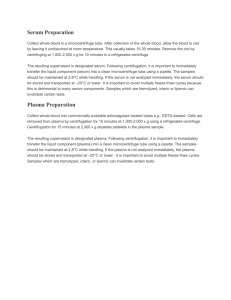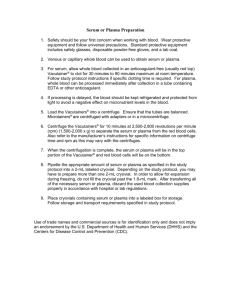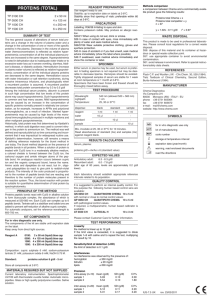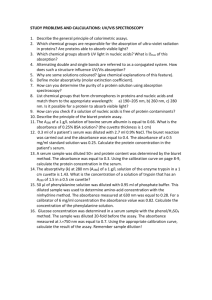Answer the following questions before coming to lab:
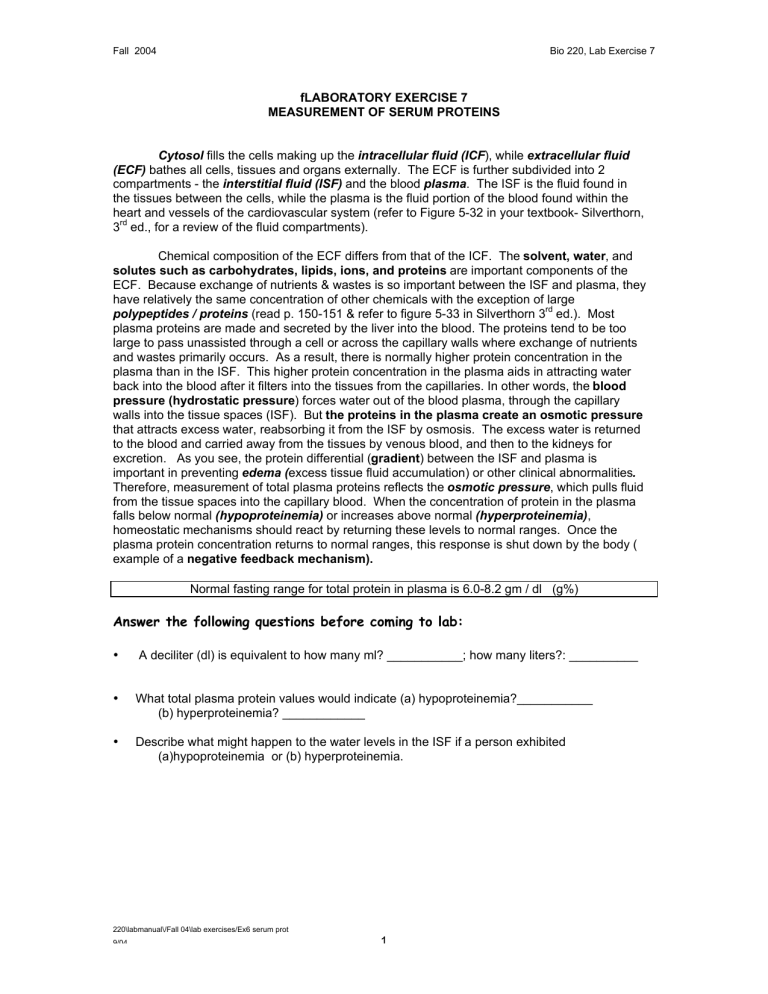
Fall 2004 Bio 220, Lab Exercise 7 fLABORATORY EXERCISE 7
MEASUREMENT OF SERUM PROTEINS
Cytosol fills the cells making up the intracellular fluid (ICF ), while extracellular fluid
(ECF) bathes all cells, tissues and organs externally. The ECF is further subdivided into 2 compartments - the interstitial fluid (ISF) and the blood plasma . The ISF is the fluid found in the tissues between the cells, while the plasma is the fluid portion of the blood found within the heart and vessels of the cardiovascular system (refer to Figure 5-32 in your textbook- Silverthorn,
3 rd
ed., for a review of the fluid compartments).
Chemical composition of the ECF differs from that of the ICF. The solvent, water , and solutes such as carbohydrates, lipids, ions, and proteins are important components of the
ECF. Because exchange of nutrients & wastes is so important between the ISF and plasma, they have relatively the same concentration of other chemicals with the exception of large polypeptides / proteins (read p. 150-151 & refer to figure 5-33 in Silverthorn 3 rd
ed.). Most plasma proteins are made and secreted by the liver into the blood. The proteins tend to be too large to pass unassisted through a cell or across the capillary walls where exchange of nutrients and wastes primarily occurs. As a result, there is normally higher protein concentration in the plasma than in the ISF. This higher protein concentration in the plasma aids in attracting water back into the blood after it filters into the tissues from the capillaries. In other words, the blood pressure (hydrostatic pressure ) forces water out of the blood plasma, through the capillary walls into the tissue spaces (ISF). But the proteins in the plasma create an osmotic pressure that attracts excess water, reabsorbing it from the ISF by osmosis. The excess water is returned to the blood and carried away from the tissues by venous blood, and then to the kidneys for excretion. As you see, the protein differential ( gradient ) between the ISF and plasma is important in preventing edema ( excess tissue fluid accumulation) or other clinical abnormalities .
Therefore, measurement of total plasma proteins reflects the osmotic pressure , which pulls fluid from the tissue spaces into the capillary blood. When the concentration of protein in the plasma falls below normal (hypoproteinemia) or increases above normal (hyperproteinemia) , homeostatic mechanisms should react by returning these levels to normal ranges. Once the plasma protein concentration returns to normal ranges, this response is shut down by the body ( example of a negative feedback mechanism).
Normal fasting range for total protein in plasma is 6.0-8.2 gm / dl (g%)
Answer the following questions before coming to lab:
• A deciliter (dl) is equivalent to how many ml? ___________; how many liters?: __________
• What total plasma protein values would indicate (a) hypoproteinemia?___________
(b) hyperproteinemia? ____________
• Describe what might happen to the water levels in the ISF if a person exhibited
(a)hypoproteinemia or (b) hyperproteinemia.
220\labmanual\/Fall 04\lab exercises/Ex6 serum prot
9/04
1
Fall 2004 Bio 220, Lab Exercise 7
PART I. PROTEIN MEASUREMENT TECHNIQUE - USE OF THE SPECTROPHOTOMETER
The spectrophotometer is a device used in physiology and clinical chemistry laboratories to determine the concentration of a substance in a solution. This is accomplished by the application of Beer’s law, which states that the concentration of a substance in a solution is directly proportional to the amount of light absorbed by the solution and inversely proportional to the logarithm of the amount of light transmitted by (passing through) the solution. The light that is used must be set to a specific wavelength. Remember that white light is made up of a spectrum of colors of different wavelengths (380 - 750 nm wavelength). Therefore, when we use the spectrophotometer, we must use monochromatic light (a single wavelength) which can be specifically selected in the spectrophotometer. The single wavelength light beam is focused on a sample within a tube called a cuvette, which is made of special glass or plastic. Some of the light will be absorbed by the sample and the remainder will pass through the sample and be read by a photoelectric cell on the opposite side of the cuvette. The sample is usually mixed with a color-producing reactant and the amount of color produced is proportional to the concentration of the product. By using a spectrophotometer, we can determine the amount of light absorbed or transmitted by the product at a given wavelength of incidental light.
Since water does not absorb any light, we use it as part of a blank in place of the sample
(biological samples are mostly water with some dissolved solutes in them ). Instead of the test sample solution, t he water is added to any working reagents, making a "blank" . Therefore, we can “zero” the spectrophotometer with water and reagents so that the only thing that will be read by the machine during an experiment will be the concentration of the proteins in the serum sample. The water and chemical reagent is then used to “zero out” the spectrophotometer, therefore, this sample is called a “blank” (no absorbance of light). An experimental sample may then be tested for the amount of light it absorbs / transmits, without worry of interference by the reagents.
Proteins in the plasma contribute to the overall osmotic concentration of the blood and also serve a variety of different functions. Some are enzymes, hormones or carrier molecules.
Some have an immune function (immunoglobulins). The majority of plasma proteins are derived from the liver. Each of the proteins differs in their molecular weight that ranges from tens of thousands to hundreds of thousands of daltons. When a total protein measurement of plasma or serum is performed, a color-producing reagent (Biuret solution) is used. Remember that Biuret is a blue solution that produces a lavender color when it reacts with proteins.
The more protein present, the darker the lavender color becomes and more light will be absorbed.
So, how do we determine concentrations of protein in plasma? We must react the protein with the Biuret reagent and compare the plasma sample to a series of known concentrations of protein, such as a variety of known concentrations of purified albumin, which is the major plasma protein . Each of these known concentrations of albumin is called a
"standard", since it has a pre-determined amount of protein and will be used for comparison with an unknown sample. Purified albumin standards and Biuret are available for purchase from biological supply companies. After reacting each standard sample with Biuret, the absorbance will be measured and we will generate a standard curve that can be graphed (A vs. [protein]).
We can insert our data from the unknown plasma sample to derive an approximate concentration of total proteins in the unknown sample. This will be demonstrated in lab.
Today you will be determining the protein concentration of a bovine serum sample (your "unknown").
I. Procedure for measurement of total serum protein (at 540nm wavelength)
WORK IN PAIRS today.
1. Obtain 7 clean plastic cuvettes and label them NEAR THE TOP: “B” (blank), “2”, “4”,
“6”, “8”, “10” & “U” ("U" stands for "unknown"). Place them into a small styrofoam cuvette rack.
220\labmanual\/Fall 04\lab exercises/Ex6 serum prot
9/04
2
Fall 2004 Bio 220, Lab Exercise 7
2. Using a P1,000 micropipettor, accurately add 1.0 ml (1,000ul) of biuret reagent to each of the 7 test cuvettes.
3. Obtain 1 each of the standards and unknown solutions from the front desk. They are in eppendorf tubes and are labeled "B, 2, 4, 6, 8, 10, U). Note: You will be given a slight excess in each of the eppendorf tubes. Using a P100 or P200 micropipettor, add the following volumes of the samples to each of the cuvettes that you previously labeled ( note : you do not have to change your pipettor tip until tube “U” ).
To test tube #B: 20 ul of distilled or deionized water ( this cuvette will be your blank )
#2: 20 ul of 2.0 g/dl protein standard
#4:
#6:
#8:
20 ul of 4.0 g/dl protein standard
20 ul of 6.0 g/dl protein standard
20 ull of 8.0 g/dl protein standard
#10: 20 ul of 10.0 g/dl protein standard
BE SURE TO CHANGE YOUR PIPET TIP BEFORE ADDING UNKNOWN TO TUBE “U”:
# U 20 ul of unknown serum sample.
4. Using a thin-tipped, disposable cuvette pipet, mix each sample by gently aspirating the solution in each cuvette( suck the solution up and down 3 times). You will only need 2 pipets: use 1 pipet to mix blank-2-4-6-8-10 in that order. Use 2 nd
pipet to mix the unknown (U). Let the tubes stand at room temperature for 10 minutes.
5. This step may be done by your instructor before you have started; check with your instructor .
Check to see that the spectrophotometer is preset to wavelength of 540 nm. Adjust the meter to
0%T with the Power Switch/Zero Control (knob on the front left side of instrument). If you cannot zero the LED readout, also use the right hand knob. Make sure that the sample compartment is empty and the lid is closed. After zeroing to 0% T, switch the spectrophotometer over to read
Absorbance by pushing the “mode” selection button (you may see the LED start blinking
1.9999999).
6. Put the Blank cuvette (B) into the sample compartment in the spectrophotometer (note: there is a black plastic adapter that will hold the cuvette in the sample compartment).
Orient the adapter with cuvette installed so that light will pass through from right to left, when placed in the spectrophotometer. Push the adapter containing the cuvette all the way down into the sample compartment . It may be tight. Blank the spectrophotometer by adjusting the meter to 0.0 absorbance with the
Transmittance/absorbance Control (knob on the front right side of instrument).
Ask your instructor if you need help.
7. In this step, you do NOT adjust any knobs, etc. You simply will read the Absorbance from the LED..
Remove the "blank" cuvette and insert each of the other cuvettes into the spectrophotometer, and read each absorbance value. Record the absorbance values of each solution in Table 1, below.
8. Using the absorbance readings of solutions “2”. “4”, “6”, “8” & “10”, plot a standard
curve on the computer, using the Excel program. Print 2 copies of the graph & data.
9. Using your standard curve printout, locate where the absorbance of the unknown serum sample plots into the graph and mark it on the standard line. Then interpolate the protein concentration of that point on the “protein concentration axis of your graph. You have just interpreted the unknown sample’s protein concentration.
Record this value in Table 1.
220\labmanual\/Fall 04\lab exercises/Ex6 serum prot
9/04
3
Fall 2004 Bio 220, Lab Exercise 7
Name: __________________________
(10 pts.) Staple this completed page to your graph and hand both in to your instructor, before leaving today. Half of your score is based on the accuracy of your unknown determination, so your technique is being tested here.
Table 1. Absorbance Readings of various protein solutions
Cuvette number
Protein Concentration
(g/dl)
Absorbance value
(A at 540 nm)
Set spect. To "0.0"
8
10
U
4
6
B
2
0 (blank)
2.0
4.0
6.0
8.0
10.0
To be determined from
Standard graph
QUESTIONS FOR FURTHER REVIEW (to be answered after the lab experiment):
1. Assuming that the normal range of plasma proteins for bovine serum should be the same as human, is the protein concentration of the unknown serum sample normal or abnormal?
2. Protein concentrations are sometimes expressed as grams percent (g%). What does g% mean?
3. (a) What is the difference between serum and plasma and (b) why did we have to use serum in this lab exercise?
4. Rate the relative protein concentrations in the 3 body fluid compartments (high to low). Why are proteins in higher concentration in the plasma than the ISF?
5. If a person had hyperproteinemia, (a) what would his/her plasma protein reading be, and (b) how would this affect the tonicity of the plasma? (c) How would the osmotic pressure of the plasma compare to that of a "normal" person's?
6. Look at your absorbance values in table 1 above. Which protein standard would have the highest transmittance? Explain the difference between transmittance and absorbance.
220\labmanual\/Fall 04\lab exercises/Ex6 serum prot
9/04
4


